This article dives deep into the vibrant customs and traditions that defined ancient Egyptian life across millennia. Rooted in religion, social hierarchy, and a deep reverence for the afterlife, these traditions spanned every aspect of daily life from marriage, divorce, and childbirth to food, fashion, law, and education. The piece explores how Egyptians celebrated festivals, navigated justice, traded goods, raised families, and treated illnesses, all while seeking eternal harmony through Maat. Through archaeological evidence, texts, and artwork, this immersive guide provides a window into the values and lifestyle of a civilization whose cultural legacy continues to captivate the world.

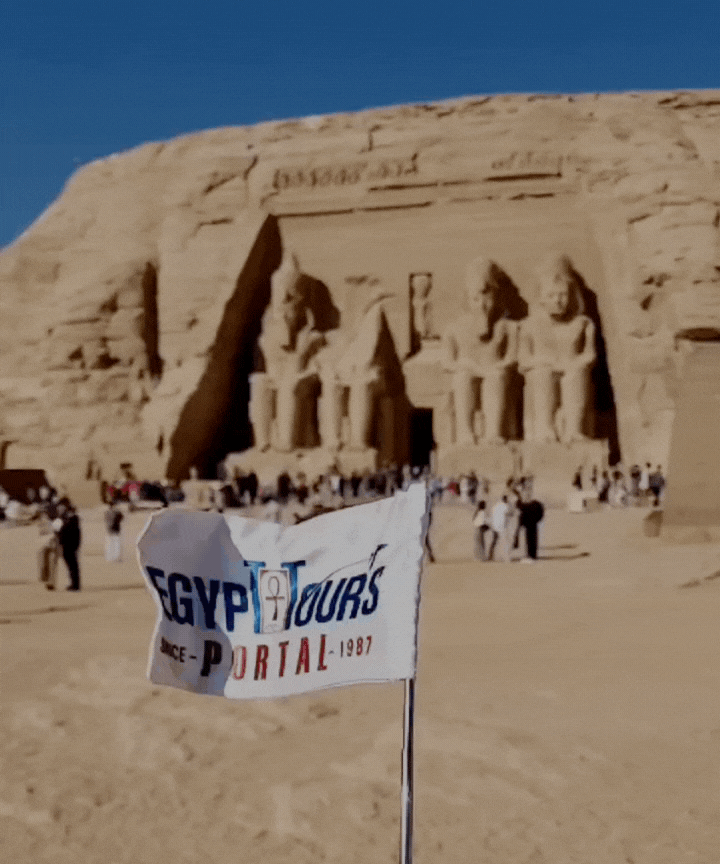
The customs and traditions of the ancient Egyptian civilization represent the embodiments of the mind and creativity of the ancient Egyptians, which reflected their social and religious constructs that guided their communities from the ages of the pharaohs until our present-day life. Since the ancient Egyptians were conservative in their way of life and were keen on preserving the old rites, which gave Egyptians from all ages a sense of continuity, serenity, and stability.
Its rich cultural heritage is marked by a plethora of traditions and customs that played a significant role in shaping its society. These customs were deeply rooted in Ancient Egyptian religious beliefs, the social hierarchy of ancient Egypt, and the cyclical nature of life. Understanding these customs gives us valuable insights into the daily lives and beliefs of the ancient Egyptians.

Ancient Egyptian marriage was not just a temporal union but an enduring commitment with implications for the afterlife. The hope of eternal reunion with one's spouse and the desire for a blissful afterlife encouraged people to treat their partners well during their lifetime and maintain their memory after their passing. In ancient Egypt, marriage ceremonies as we know them today did not exist. Instead, a woman was considered married to a man once she entered his house with the agreed-upon goods. Marriages were typically arranged by the parents, with a bride price and reciprocal gifts exchanged between the groom's and bride's families.
Despite the transactional nature of these arrangements, pre-nuptial agreements were common, and the bride retained ownership of her possessions even after marriage. The main purpose of marriage in ancient Egypt was to have children, but it was also expected that the couple would love and honor each other. Love and respect were encouraged, as evident from the teachings of sages like Ptah-hotep and Ani, who emphasized the importance of treating one's wife well and maintaining a happy household. Marriage settlements were drawn up by the groom and the bride's father, and upon signing before witnesses, the couple would be considered married.
In case of divorce, the children belonged to the mother. Despite societal norms, women in ancient Egypt had significant freedom within marriage, and many couples seemed to enjoy positive, loving relationships. Tomb paintings and other forms of art and inscriptions depicted husbands and wives eating, dancing, and working together, highlighting their shared life experiences. While royal families could practice sibling marriages, it was discouraged among common people, who were encouraged to marry outside their bloodlines.
Marriages often took place at young ages, with girls marrying as young as 12 and boys at 15, though the average ages were around 14 for girls and 18-20 for boys. Boys would have already learned their father's trade, while girls were trained in household management and caregiving. The stability of the nuclear family unit was considered crucial for a stable society. Although not all marriages worked out, divorce was granted in such cases. Overall, while ancient Egypt was a male-dominated society, there were instances of positive and loving relationships between husbands and wives.
Marriage was viewed as a lifelong commitment that extended into the afterlife. Although the life expectancy of ancient Egyptians was relatively short, the belief in eternity and the afterlife played a significant role in shaping the approach to marriage. Tomb paintings and inscriptions depicted couples enjoying each other's company in the Field of Reeds, the afterlife realm, engaging in activities they loved during their earthly life. The Egyptian concept of eternity was closely linked to the idea of an everlasting existence. There was no notion of a separate heavenly realm; instead, eternity represented a continuation of one's earthly life.
To ensure a pleasant and eternal existence, individuals sought to make their lives and the lives of others as pleasurable as possible. Upon death, one faced judgment before Osiris, the god of the afterlife, and if deemed worthy, they would pass on to the Field of Reeds. In this realm, the deceased would find everything they had left behind on Earth, including their home, favorite things, and most importantly, their loved ones, including their spouse. The hope of reuniting with a beloved spouse in the afterlife provided comfort and consolation after their loss on Earth.
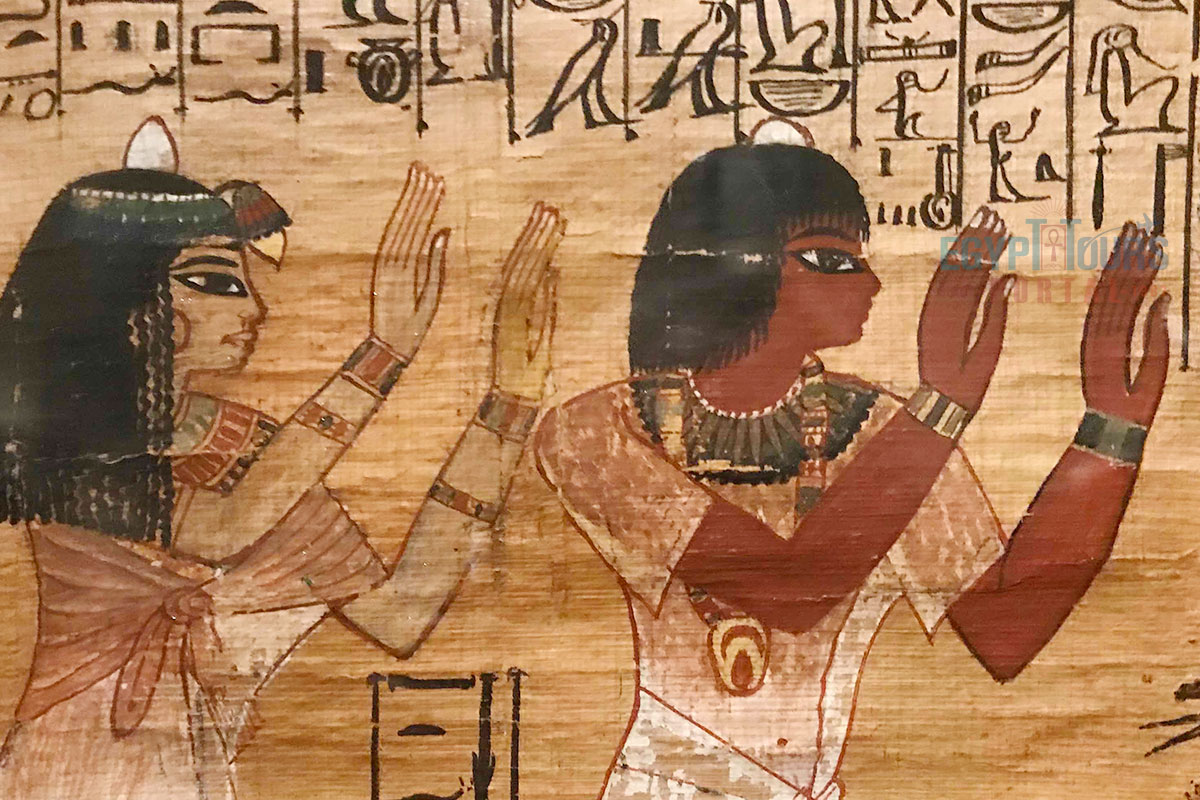
The process of ending a marriage was relatively straightforward. If one or both spouses wanted a divorce, they could request it, and the material possessions would be divided according to the pre-nuptial agreement that had been made before marriage. This practice required a flexible mindset concerning property rights and the economic well-being of the ex-wife, as all possessions, including those the husband may have considered his own, were divided based on the original agreement. Anything the wife had brought into the marriage was allowed to be taken with her when the marriage ended. The only situation where a woman might lose her rights in divorce was if a charge of infidelity was substantiated.
Over time, divorce proceedings in the New Kingdom and Late Period became more complex, with a greater level of codification and central authority involvement. Many documents from this era resembled actual marriage contracts. In cases of divorce, the dowry provided by the groom during the marriage would revert to the wife, providing her with financial support, or a single payment might be given to her. Alimony payments were also an option, with the ex-husband sending a monthly stipend to his former wife until she remarried, even if they had no children together. This ensured some financial stability for the ex-wife after the divorce.

The ancient Egyptians believed that the birth of a child was like the rising of the sun, where the young sun god needed protection from the savage, hostile forces of the day. In ancient Egypt, infant mortality was very high, The ancient Egyptians had several customs to protect the newborn babies from all the evil and chaotic forces at the moment of daybreak during the life of the boy or girl. The process and custom of childbirth were a heavily religiously charged event.
Known from the papyrus texts, there were standard practices of childbirth as the women would deliver her baby while squatting on two massive bricks which were decorated with many scenes that desired the power and magic and the ancient Egyptian gods and goddesses in the purpose for acquiring the best happiness and health of the mother and child. A 14 by 7 inches brick of that kind was discovered in Abydos inside a 3700-year-old house, which held some informative decorations.
The brick was found on the section of the house that was occupied by women, plus several clay seals that held the name of a noblewoman and the king's daughter Renseneb. One of the most famous scenes on the excavated house in Abydos is the scene of the mother with her newborn boy standing next to Hathor, the cow goddess of fertility, motherhood, and joy. There were scenes of the guardians of the sun god on the golden sides of the brick that appeared in symbolic form, the shape of the guise of a cat, which provides the finest magical protection for the child and the mother.
The ancient Egyptians had the power to accurately detect the sex of the unborn babies, which enabled them to choose the name of the child before the birth. The women urinated on wheat and barley seeds, and if the wheat grew, then the baby was a girl, and if the barley grew, then the baby was a boy.

In ancient Egypt, the Pharaoh ensured his people had abundant and diverse food options. The fertile soil, left behind by the annual flooding of the Nile river, facilitated the cultivation of crops, resulting in a variety of delicious and nutritious foods. The staple diet consisted of bread and beer, which were sweetened with dates, honey, or figs. They had both flatbreads and yeast breads made from barley and wheat. Beer was a common drink due to the scarcity of wells and the belief that Nile water caused sickness.
The beer was thick and nutritious, an essential part of their daily diet. The art of culinary preparation in various ways was mastered by the Egyptians, allowing them to stew, bake, boil, grill, fry, and roast their food to perfection. To enhance the taste, they skillfully incorporated spices and herbs, although these luxurious ingredients were reserved for the affluent due to their high cost as imports. To preserve meat, the common method was salting, while dates and raisins were dried for extended storage periods, ensuring a steady food supply.
The ancient Egyptians enjoyed a wide range of foods, including garlic, green vegetables, lentils, figs, dates, onions, fish, birds, eggs, cheese, and butter. While some fish were considered sacred, others were roasted, dried, or salted for consumption. Meat, especially beef, was a delicacy primarily enjoyed by the upper class. For desserts, they had a fondness for sweet treats made with bread, cream, and honey as a sweetener, as well as a bread-cake-like delicacy.
Both white and red wines, spiced with honey, were made from grapes, and a non-alcoholic fruit drink was crafted from dates. Despite some restrictions on sacred animals and a brief period when pigs were removed from the diet, there was generally no scarcity of food in ancient Egypt, thanks to the centralized storage and sharing of grain. Everyone had access to fresh food, and the lower class commonly consumed fresh bread, onions, vegetables, fish, eggs, and beer. The dining customs varied between the ancient Egyptian social classes.
The upper class enjoyed meat, milk, wild birds, and eggs, with dinners served individually on small tables. They ate with their fingers and rinsed their hands between courses. In contrast, the lower class ate their meals while lying on mats woven from reeds, sharing simpler but still nutritious foods.
Explore the marvelous and diverse foods & drinks the ancient Egyptian civilization
Read More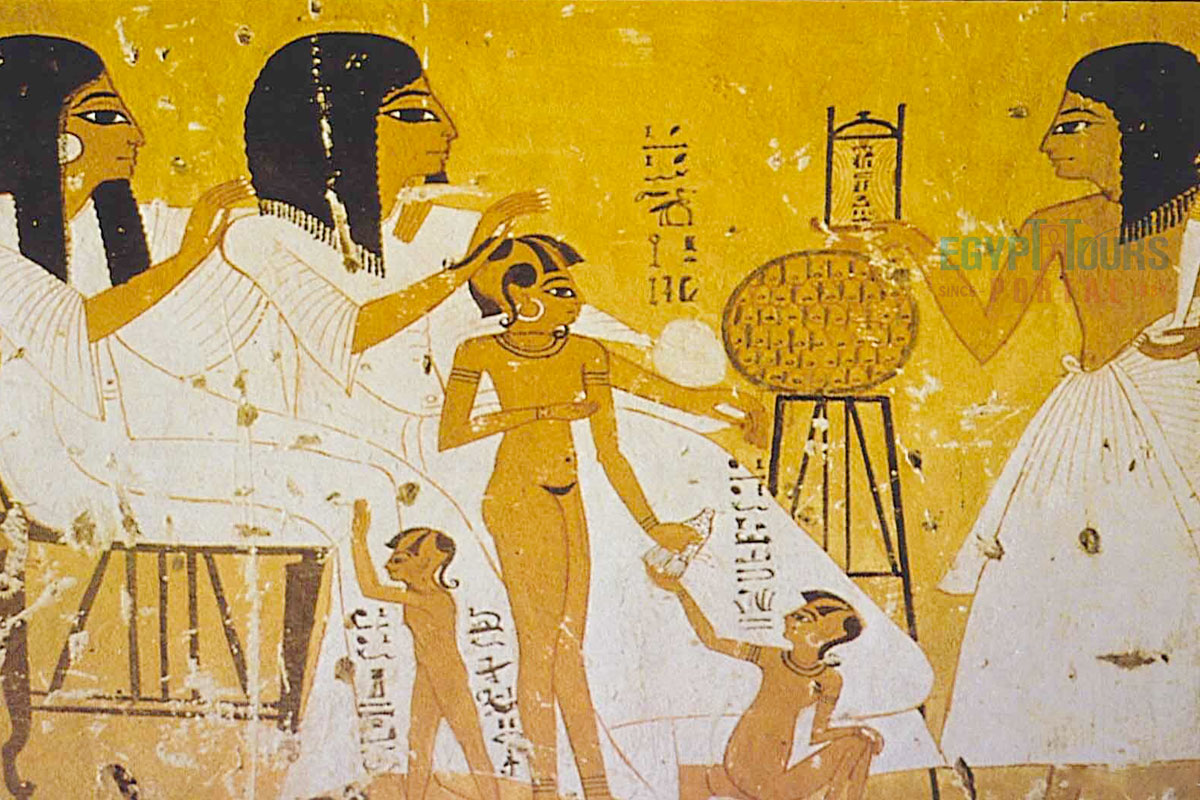
Ancient Egyptian Clothing was not only stylish but also adapted to the region's climatic conditions and reflected the wearers' social status. Ancient Egyptian clothing, spanning from before 3100 BC to 30 BC, was vibrant and comfortable, designed to combat the hot desert climate. Linen, made from the flax plant, was the most common fabric, while wool was considered impure and forbidden in certain places.
Peasants typically wore a shenti (made of flax), while the wealthy adorned themselves with animal fibers and precious gems. Pharaohs donned elaborate clothing, including animal skins as a symbol of their status. Men's clothing was simple, with wrap-around skirts and pleated loincloths, while women mostly wore a conservative sheath dress called a kalasiris. Children went without clothing until the age of six, after which they wore garments for protection. Wigs made from human hair were popular among the wealthy, often styled with tight curls and braids.
Jewelry was a significant part of Egyptian attire, made from gold, silver, and colorful stones. The use of cosmetics, such as black kohl for eyes and red ochre for lips, was widespread, and perfumes were highly sought after. Footwear, usually coiled, sewn leather sandals, was worn on special occasions or to protect feet from harm.

Greetings and social etiquette in the daily life of ancient Egypt were a complex and nuanced system that reflected the values and beliefs of the society. The ancient Egyptian community was highly advanced and extremely Sophisticated, built on the foundation of mutual respect and politeness, where everyone greeted one another with the best salutes and greetings that were accompanied by bowing or prostrating, and handshakes were uncommon.
Hierarchical relationships were strictly observed, with proper deference shown to superiors. As mentioned, the royal titles were one of the best means of respect for the individual character and social status. Hospitality was highly valued, and guests were offered food and drinks as a sign of respect.
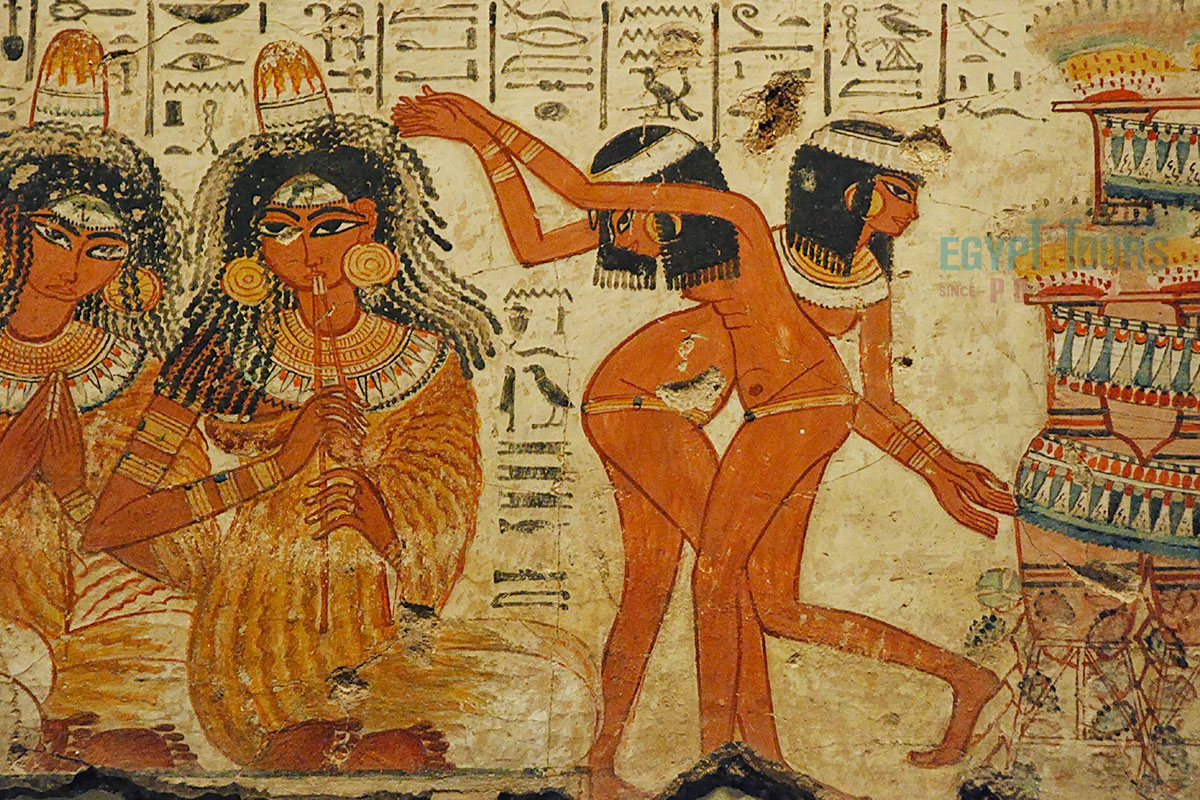
Ancient Egyptians had a strong passion for music and created a diverse range of instruments suitable for various skill levels. They crafted simple instruments like drums, bells, rattles, tambourines, chimes, and clapping hands to ensure everyone could participate in musical experiences. Additionally, they designed more complex instruments like the flute, guitar, and harp, requiring practice and skill to play proficiently. The flute, possibly one of the earliest wind instruments globally, likely originated from hollow reeds found along the Nile. Holes were later added to create a fully functional flute.
The guitar, resembling a lute-like instrument, featured a soundbox and a long neck with strings stretched across, producing a variety of sounds when manipulated. Mastering the guitar demanded time and dedication. Harps, initially fashioned from hunting bows, eventually evolved to have 10-12 strings. Music can go hand in hand with singing, which played a central role in religious festivals, celebrations, banquets, and the overall happiness and well-being of the ancient Egyptian people.
Temple priests, comprising both men and women throughout their history, incorporated music and dance into their religious practices. In the New Kingdom, the priesthood consisted mainly of males, but few priests were married, and their wives played their role as the moan singers and dancers of the temple. Most of the songs and dances performed by the temple’s women remained very significant in ancient Egyptian culture.
Dancing held significant importance in ancient Egyptian culture, but men and women were never depicted dancing together. The art of dance was performed by male pairs during the Old Kingdom. Dance groups were common in various settings, such as dinner parties, banquets, and religious temples. Wealthy women from harems were trained in music and dance and performed for royalty, accompanied by male musicians. Public dancing was considered a privilege of the lower classes, and the wealthy kept slaves to entertain at their gatherings.
The oldest known depictions of dance in Egypt date back to the Predynastic era, and scenes of dancers appeared in Old Kingdom tombs associated with funerals. Professional groups of singers, musicians, and dancers entertained at festivals and funerary services. Female dominance in these groups was evident until the later days of the Old Kingdom.
Foreign dancers and musicians became more prevalent in the New Kingdom. Female dancers rarely wore the typical dress, instead opting for more revealing costumes, while male dancers wore skirts or aprons. Dances in ancient Egypt could be solo, pair, or group performances. Funeral dances played an important role, and specialized troupes of dancers were dedicated to ceremonies associated with death and the afterlife. Dwarfs and pygmies were also hired for special occasions and farewell performances.
Explore the rich entertainment of the ancient Egyptian civilization
Read More
Ancient Egyptians celebrated various events with parties or festivals according to their usual customs. These included birthdays of gods and individuals, anniversaries of significant royal deeds, acts of gods in human history, funerals, wakes, house-warming events, and births. Each festival had its unique characteristics, but they all involved drinking and feasting. The Egyptian diet mainly consisted of grains and vegetables, as meat was expensive and difficult to preserve in the arid climate. However, festivals allowed indulgence in excesses, including meat eating for those who could afford it.
Different ancient Egyptian festivals were celebrated in honor of various gods, such as the Beautiful Feast of the Valley for Amun and the Feast of Hathor at Dendera. These events involved processions, music, flowers, and sometimes intoxication. Festivals were usually religious and followed the lunar calendar, but some also commemorated specific events in daily life. At funerals, people wore respectful black attire, while at other celebrations, they dressed more freely. For example, during the Festival of Bastet, women often wore only short kilts, raising them in honor of the goddess.

Ancient Egyptians performed rituals involving offerings of food, drink, clothing, and ointment to their deities, aiming to gain their favor. Temples of ancient Egypt conducted daily morning offering ceremonies, where high-ranking priests or the pharaoh dressed the god's statue and presented it with offerings. Afterward, the ancient Egyptian priests distributed the offerings among themselves. Additionally, individuals practiced personal piety by praying to gods and making private offerings, which became more prominent in the late New Kingdom as belief in direct divine intervention grew.
Ancient Egypt is renowned for its burial practices and famous sites like the pyramids and the Valley of the Kings, which preserve Egyptian mummies and artifacts from daily life. Among the mysteries of this ancient civilization, the topic of sacrifices has captured curiosity. While scholars debate the extent and nature of sacrifices in Ancient Egypt, there is consensus that both animal and human sacrifices occurred at certain points in their history.
Sacrifices were primarily carried out by the Egyptian elite, who believed in the importance of providing for their ka (the soul after death) in the afterlife. As part of their religious understanding, people were buried with their favorite pets and livestock, ensuring companionship and care for their ka. Cats, jackals, crocodiles, ibis, hawks, and various other ancient Egyptian animals have been found preserved in Egyptian tombs. For a deeper understanding of Egyptian sacrifice and funeral rituals, researchers can explore specific research materials and the Book of the Dead, a significant source shedding light on their cultural heritage and beliefs about the afterlife.
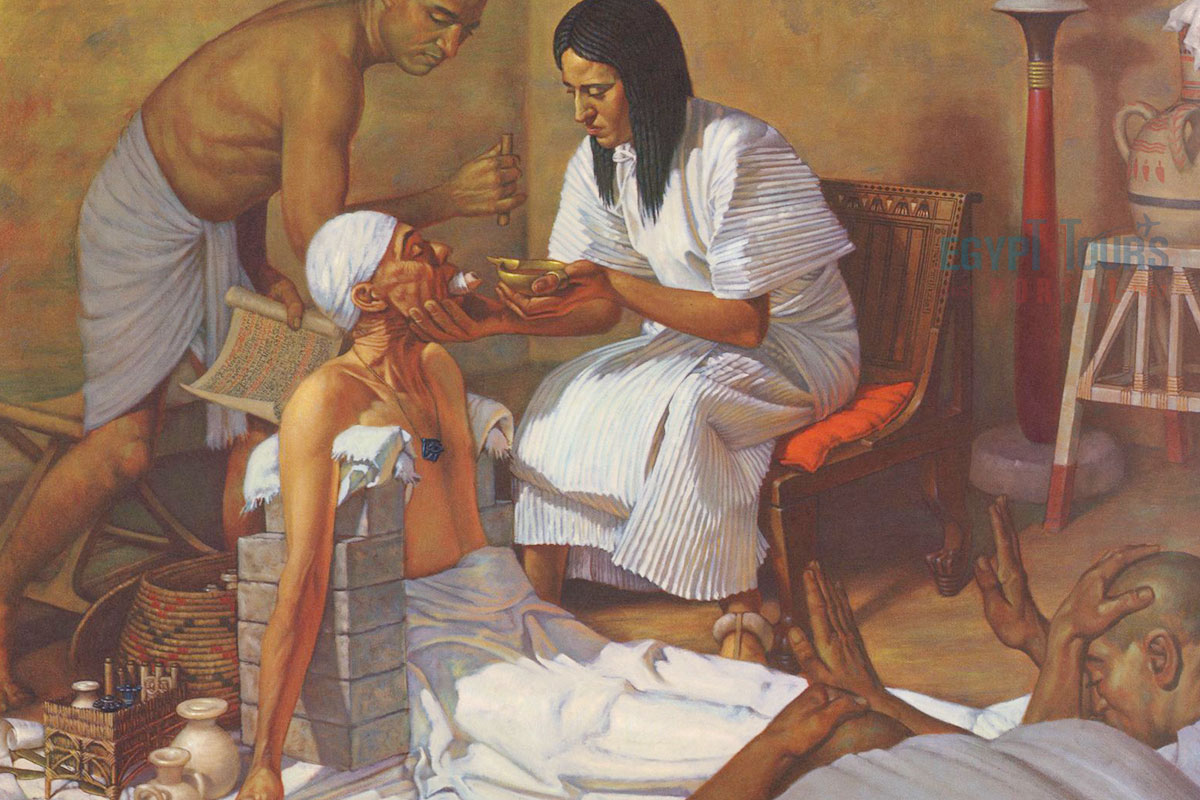
Ancient Egyptian doctors practiced a combination of practical ancient Egyptian medicine and magic, as they believed diseases had supernatural origins. Offerings were made to the gods for their favor, and temples conducted daily morning offering ceremonies. Although modern scholars cannot fully validate the effectiveness of these practices due to the limited understanding of the ancient Egyptian texts, Egyptian medical practices were admired by the Greeks. The god Heka presided over medicine and magic that was represented by a staff with two serpents, later known as the caduceus, and various deities were invoked for healing purposes.
Other healing deities, such as Sekhmet, Serket, Sobek, and Nefertum, were invoked in medical procedures and spells. Treatments often involved a combination of practical medicine and spells. Some medical texts focused on surgical treatments for injuries, while others offered prescriptions for diseases or skin conditions. They often used herbs and spices medicinally, and some treatments included gum balls made of honey, cinnamon, myrrh, frankincense, and pignon to cure bad breath.
Tooth extraction and false teeth with opium as an anesthetic were evidence of their dental practices. The Egyptian doctors used a variety of herbs and natural substances to create pharmaceuticals, which were carefully dispensed with specific instructions. Successful surgeries and prosthetic limbs have been found in archaeological remains. However, the translation of ancient Egyptian medical texts poses challenges due to unclear descriptions and assumptions about common knowledge among doctors.

The ancient Egyptians embraced the value of enjoying life to the fullest, focusing on physical well-being and spiritual growth, with recreational activities playing a central role in achieving these goals. The ancient Egyptians valued and appreciated life greatly, believing it to be an eternal journey filled with magic. They considered life a gift from the gods and embraced the idea of living it to the fullest. This perspective is reflected in their culture, which emphasized the enjoyment of life and the pursuit of well-being.
Recreational activities played a significant role in ancient Egyptian life. Physical fitness was vital, and they engaged in various sports and games to maintain health and vigor. Sports like Senet (similar to checkers) were more intellectual pursuits, while physical activities like field hockey, wrestling, and rowing were popular among both children and adults. Children, regardless of social class, spent much time outdoors, playing games and participating in sports. Toys played a crucial role in their entertainment, with clay or wooden figures of men and women, animals, and various objects being common playthings.
Sports were not only recreational but also held cultural and religious significance. They were integrated into religious ceremonies, festivals, and even the king's coronation. The game of Senet, in particular, was associated with the journey through life towards eternity, as it was depicted being played by people and gods in the afterlife. Physical fitness and athleticism were considered essential for all, from commoners to royalty.
The nobility enjoyed watching and participating in sports, such as shooting the rapids and archery. They also appreciated women's gymnastic dance competitions, swimming, and rowing. Aside from sports, storytelling was another popular form of recreation for the ancient Egyptians. Stories of gods, heroes, and magical adventures were shared during gatherings and parties, offering both entertainment and moral lessons.
Explore the diverse sports of the ancient Egyptian civilization
Read More
Acquiring the best possible education was the ultimate tradition for ancient Egyptians to create Utopia. Ancient Egyptians highly esteemed education and knowledge, which significantly influenced their society's structure, governance, and religious practices. Education was primarily accessible to the elite classes, particularly the children of nobles who aspired to become scribes. These privileged individuals received formal education in hieroglyphics, ancient Egyptian mathematics, ancient Egyptian astronomy, and religious texts, enabling them to play essential roles in administration and communication.
The most prestigious form of education was the scribal school, where boys and some girls from privileged families learned reading, writing, mathematics, and hieroglyphic script. Scribes played vital roles in record-keeping and administration, making their education highly valued. Additionally, priests received specialized education in religious practices, rituals, and religious texts.
The ancient Egyptians had a solid understanding of basic mathematics, as it was crucial for tasks like surveying land and building structures. They also studied astronomy to observe celestial events, which held significant importance in their religious beliefs. Medical knowledge was transmitted through oral traditions and apprenticeships, leading to the development of skilled individuals known as "physicians" who excelled in herbal remedies, surgery, and diagnosing illnesses.
The Egyptians produced a vast body of ancient Egyptian literature, including religious texts, myths, poetry, and wisdom literature, which were often part of the education of the elite. These texts were used to impart moral values and principles. Intellectual pursuits were common among the educated elite, involving philosophical and moral discussions. The ancient Egyptians pondered profound questions about life, ethics, and the afterlife, as evident in their literary works.
Explore more magnificent details about the rituals, beliefs, and customs of the religion of the ancient Egyptians.
Read More
Agriculture formed the foundation of the ancient Egyptian economy, with the Nile River's yearly flooding providing nutrient-rich soil for crop cultivation. The fields were so fertile that they produced surplus food, which was stored in granaries and used for trade. The ox-drawn plow and irrigation canals were essential tools for farming. The staple crops included emmer, chickpeas, lentils, lettuce, onions, garlic, sesame, wheat, barley, and flax. Opium poppies were also cultivated for medicinal and recreational purposes.
Papyrus was used for various products, and emmer was a crucial ingredient in beer and bread, the most popular drinks and food in ancient Egypt. Ancient Egyptian farmers in ancient Egypt married at a young age as a custom and were advised to have more children, as those with more children were respected. They treated their wives tenderly and with respect. Unfaithful wives were punished severely, sometimes with death. Peasants preferred having sons over daughters, and there were methods for predicting pregnancy and determining the gender of unborn babies.
Means of Contraception were practiced by some women, and magic was used to aid in conception. Upon death, the eldest son inherited the father's property and was responsible for the burial rites. Peasants had religious customs related to agriculture, including festivals for the Nile flood and harvest celebrations. They thanked deities associated with agriculture and offered first fruits to local gods. They believed in lucky and unlucky days, and they maintained traditions related to the Year of Nature.
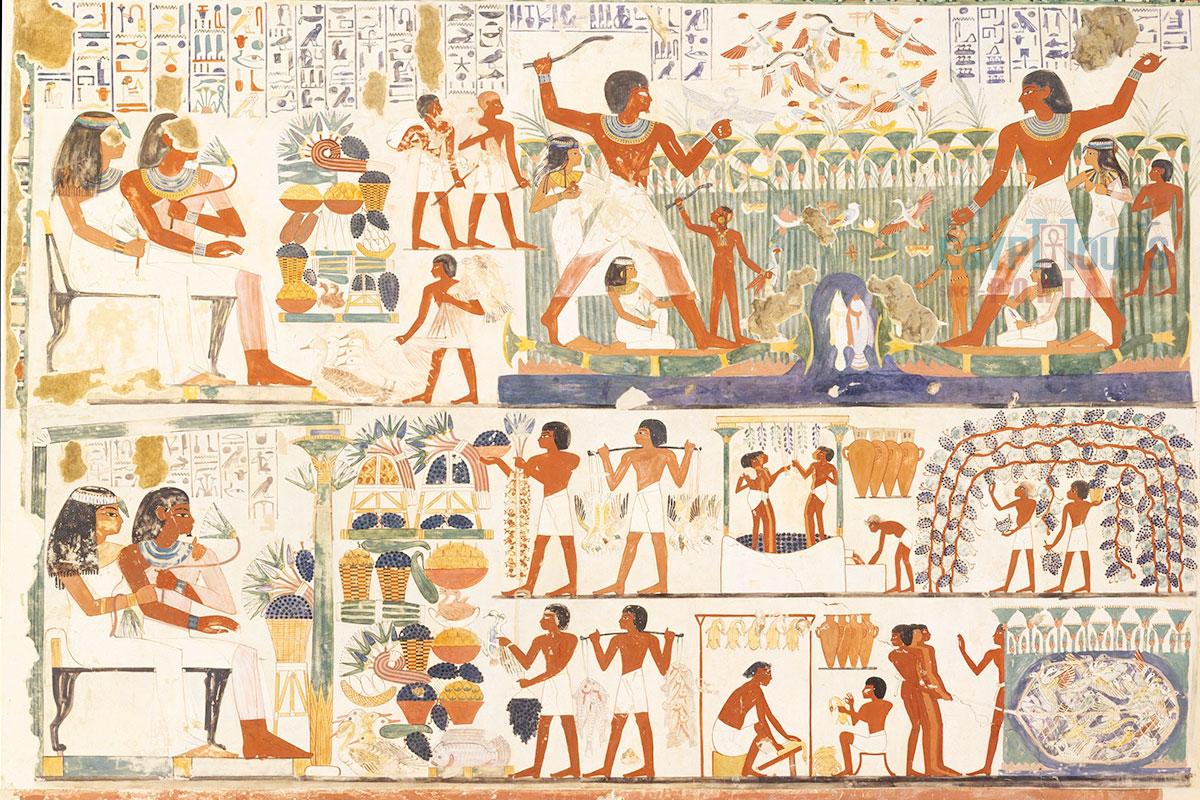
Trade has always been essential for civilizations, including ancient Egypt. From the Predynastic Period to the Roman era, trade operated on a barter system using a unit called a "deben" as a standard of value. Early trade partners included Mesopotamia, which influenced ancient Egyptian art and culture. Trade expanded during the First Dynasty, involving regions like the Levant, Libya, and Nubia. Nubia's trade center, known as Yam, was rich in wood, ivory, and gold. The New Kingdom saw a surge in luxury trade, with Egypt engaging with various countries in the Mediterranean region.
Trade incentives were driven by priests who owned land and traded for temple profits. There were no government-sponsored trade incentives, as the king owned all the land and its produce. However, priests, especially from the Cult of Amun, owned tax-exempt lands and engaged in trade, living comfortably. Agricultural produce was collected as government revenue, with some used for trade, generating income for the state. The king's responsibility was to care for the people and maintain harmony (ma'at).
To protect trade, armed guards and escorts were employed. Theft of goods was a significant concern, and the responsibility fell on the expedition organizers. Some of the customs retailing to the ancient Egyptian trade included that individual farmers made a living from their crops in various ways. Private landowners had more freedom in managing their crops, but had to pay taxes to the state. Most farmers worked on land owned by ancient Egyptian nobles, priests, or wealthy individuals, and they would surrender the produce to the landowner while keeping a small portion for themselves.
Women and children in these households tended small gardens for family use, but agriculture was primarily considered men's work. Women were involved in informal exchanges, bartering surplus goods with neighbors. Fishing was a common activity for lower-class Egyptians to supplement their income. Ancient Egypt was a cashless society until the Persian Invasion in 525 BCE, making bartering an essential aspect of the economy.
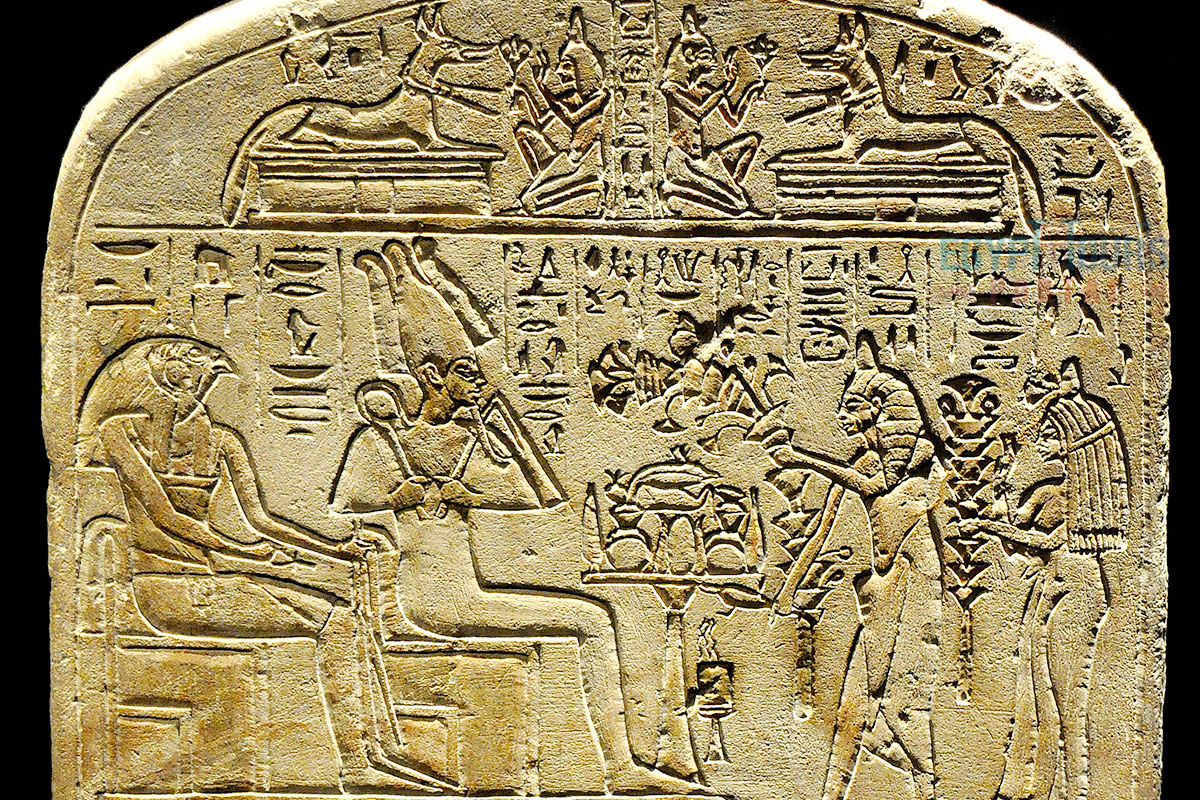
Legal and Judicial Customs in ancient Egypt played a crucial role in establishing prosperity, balance, and lasting peace. The ancient Egyptians developed a sophisticated and highly regulated legal system, which was believed to be handed down by the gods. The system had a judicial hierarchy, with the king at the top, acting as the main representative of the gods' divine justice. The legal system was organized regionally into districts called "Nomes," each presided over by a nomarch and his steward. In the early period, priests served as judges, consulting the gods for verdicts, but later, professional judges were hired, leading to a more rational pattern.
The courts consisted of three levels: the Seru for village cases, the Kenbet for regional and national cases, and the Djadjat as the imperial court. The ancient Egyptians believed in divine justice, with gods responsible for maintaining order and punishing the unjust. Their legal system depended on fairness, truth, and symmetry, rooted in the concept of Maat, embodying balance and harmony. Punishments for crimes were severe, including death for murder and adultery.
The legal system covered various areas, such as property disputes, divorce, and business arrangements. The ancient Egyptians believed in the sanctity of life and strict adherence to their laws, which were enforced by a professional police force. Crimes like theft, bribery, treason, grave robbing, rape, and violence were punished accordingly, and false charges were severely dealt with. The concept of Maat shaped their moral principles and societal order, guiding their actions towards creating a just and well-ordered society.
While the legal system was effective in maintaining social harmony, its efficiency declined during the final days of the New Kingdom due to increasing violations and corruption. The police force handled capturing the accused and putting them in front of the judges who also gave their testimonies in front of the judges.
Explore more marvelous details about the legal, crimes, and court systems of the ancient Egyptians.
Read MoreAncient Egyptian traditions and customs were deeply intertwined with their religious beliefs, social structure, and agricultural practices. These customs shaped their daily lives, rituals, and ceremonies, contributing to the vibrant and enduring civilization that left an indelible mark on history and inspired the innovation of a number of other ancient civilizations.
Studying these customs provides us with valuable insights into the complexities and richness of ancient Egyptian culture. We offer excellent Egypt Tours from Australia and an amazing Nile river cruise that will deliver magical cultural experiences across the rich culture of the greatest travel destination on earth.
Private 4 Days Cairo Tour Packages for Australian Travelers 4 days Cairo Egypt Tour ...
Tour Location: Cairo – Giza...
5 Days Cairo and Alexandria Tour Package For Australian Travelers 5 days Cairo and A...
Tour Location: Cairo/Giza/Alexandria...
6 Days Cairo, Luxor & Aswan Tour Package For Australian Travelers 6 days Cairo, ...
Tour Location: Cairo/Giza/Aswan/Luxor...
Amazing 7 Days Cairo and Hurghada Holiday for Australian Travelers 7 Days Cairo &...
Tour Location: Cairo – Giza – Hurgh...
The entire country of Egypt deserve to be explored with its every heavenly detail but there are places that must be seen before any other such as the breathtaking Hurghada's red sea, The wonders of Cairo the pyramids of Giza, the great sphinx, the Egyptian Museum, Khan El Khalili Bazaar, the wonders of Luxor like Valley of the Kings, Karnak & Hatshepsut temple and the wonders of Aswan such as Abu Simbel temples, Philea temple, Unfinished obelisk and The Wonders of Alexandria like Qaitbat Citadel, Pompey's Pillar and Alexandria Library. Read more about the best places to visit in Egypt.
If you want to apply for a Visa On Arrival that lasts for 30 days then you should be one of the eligible countries, have a valid passport with at least 6 months remaining and pay 25$ USD in cash, as for the E-Visa for 30 day you should have a valid passport for at least 8 months, complete the online application, pay the e-visa fee then print the e-visa to later be presented to the airport border guard. You could also be one of the lucky ones who can obtain a free visa for 90 days. Read more about Egypt travel visa.
Egypt has a variety of delicious cuisines but we recommend “Ful & Ta’meya (Fava Beans and Falafel)”, Mulukhiya, “Koshary”, a traditional Egyptian pasta dish, and Kebab & Kofta, the Egyptian traditional meat dish.
The best time to travel to Egypt is during the winter from September to April as the climate becomes a little tropical accompanied by a magical atmosphere of warm weather with a winter breeze. You will be notified in the week of your trip if the Climate is unsafe and if any changes have been made.
You should pack everything you could ever need in a small bag so you could move easily between your destinations.
We have been creating the finest vacations for more than 20 years around the most majestic destinations in Egypt. Our staff consists of the best operators, guides and drivers who dedicate all of their time & effort to make you have the perfect vacation. All of our tours are customized by Travel, Financial & Time consultants to fit your every possible need during your vacation. It doesn't go without saying that your safety and comfort are our main priority and all of our resources will be directed to provide the finest atmosphere until you return home.
You will feel safe in Egypt as the current atmosphere of the country is quite peaceful after the government took powerful measures like restructuring the entire tourist police to include all the important and tourist attractions in Egypt. Read more about is it safe to travel to Egypt.
Wear whatever feels right and comfortable. It is advised to wear something light and comfortable footwear like a closed-toe shoe to sustain the terrain of Egypt. Put on sun block during your time in Egypt in the summer to protect yourself from the sun.
The best activity is by far boarding a Nile Cruise between Luxor and Aswan or Vise Versa. Witness the beauty of Egypt from a hot balloon or a plane and try all the delicious Egyptian cuisines and drinks plus shopping in old Cairo. Explore the allure and wonders of the red sea in the magical city resorts of Egypt like Hurghada and many more by diving and snorkeling in the marine life or Hurghada. Behold the mesmerizing western desert by a safari trip under the heavenly Egyptian skies.
There are a lot of public holidays in Egypt too many to count either religious or nation, the most important festivals are the holy month of Ramadan which ends with Eid Al Fitr, Christmas and new years eve. Read more about festivals & publich holidays in Egypt.
Egypt is considered to be one of the most liberal Islamic countries but it has become a little bit conservative in the last couple of decades so it is advised to avoid showing your chest, shoulders or legs below the knees.
Arabic is the official language and Most Egyptians, who live in the cities, speak or understand English or at least some English words or phrases. Fewer Egyptians can speak French, Italian, Spanish, and German. Professional tour guides, who work in the tourism sector, are equipped to handle visitors who cannot speak Arabic and they will speak enough English and other languages to fulfill the needs of all our clients.
The fastest way is a car, of course, a taxi. If you are in Cairo ride a white taxi to move faster or you could board the fastest way of transportation in Egypt metro if the roads are in rush hour.
The temperature in Egypt ranges from 37c to 14 c. Summer in Egypt is somehow hot but sometimes it becomes cold at night and winter is cool and mild. The average of low temperatures vary from 9.5 °C in the wintertime to 23 °C in the summertime and the average high temperatures vary from 17 °C in the wintertime to 32 °C in the summertime. The temperature is moderate all along the coasts.
It is the home of everything a traveler might be looking for from amazing historical sites dating to more than 4000 years to enchanting city resorts & beaches. You will live the vacation you deserve as Egypt has everything you could possibly imagine.









